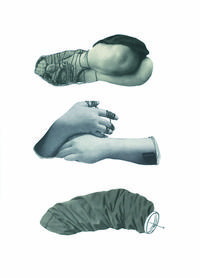Eva Koťátková & Ketty La RoccaUnlearning the Body–Haus Esters
With Eva Koťátková (b. 1982) and Ketty La Rocca (1938–1976) the Kunstmuseen Krefeld are presenting two artists whose works enter into a multifaceted cross-generational dialogue. The focus is on the body as the carrier of physical and mental character and upbringing, as an expression of alienation and speechlessness as well as a medium for potential new forms of communication. The role of the individual in an environment defined by standards is particularly noticeable through their close artistic proximity with a view to the historical as well as contemporary relevancy.
For both artists this show represents their first major presentation a Rhenish museum. Ketty La Rocca, whose work developed over the course of only ten years, from the mid 1960s to her untimely death in 1976, was one of the most important exponents of concept and body art in Italy. The exhibition brings together a selection of her central groups of works, starting with the early collages from magazines that are underlayed with socio-critical commentaries to performances, films and photographs in which hands become the protagonists of a new language as well as the x-rays of her own skull that the artist superimposes with pictures of her hand and inscribes with the mantra-like repeated word “You”.
The work of the Czech sculptor Eva Koťátková, who caused a sensation with her installation at the 2013 Venice Biennale, develops as a surreal, often disturbing narrative. The artist brings Haus Esters to life in the form of a stage with scenarios comprising fragmented bodies and props that ostensibly serve questionable pedagogical purposes. The puppet theatre conceived for this year’s Art Basel, which exemplarily explores manipulated action and behavioural role, will be shown in a new form as an installation. The history of Haus Esters resonates in the concept of the exhibition developed for Krefeld, the ground plan of which is based on traditional family structures with separate spaces for women, men and children. Symbolising pedagogical conventions as it were, Eva Kot’átková developed cage-like objects based on historical baby walkers that are both supportive and confining. Intended for use in the exhibition, the visitor can create his own experience space by means of these walking aids.
The exhibition will be accompanied by a catalogue.

